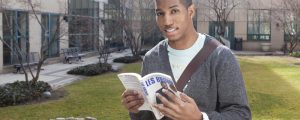29 Healthy Practices and the Wellness Wheel
Learning Objectives
In this section you will:
○ Reflect on your own health and wellness
○ Develop ideas for healthy practices
○ Consider different forms of wellbeing
Introduction
Health and wellness are foundational to student success. Yet we do not always have control over our own wellbeing: social environments, personal background, economic status, race, gender, and belief systems all have an impact on our health, for instance. Leading a healthy life can be particularly challenging for college students as they navigate new academic and personal challenges and increased responsibilities. Between classwork, jobs, and family obligations, it’s often hard to get enough rest or eat a healthy meal. You, like many of your peers, may deal with anxiety, mental health conditions, or chronic illness, and may wonder how to achieve a healthy and balanced lifestyle. In this section, we invite you to consider your own health, learn about healthy practices and different components of wellbeing, and explore what steps you can take to take care of yourself and others.
Reflection
First, take a moment to reflect on the following questions:
- What does wellbeing mean to you? In other words, what makes you feel healthy and well? What does not?
- What are the challenges you face in pursuing your own wellbeing?
- What would help you live a healthy life?
Healthy Practices
In her book Undrowned: Black Feminist Lessons from Marine Mammals, Alexis Pauline Gumbs encourages us to learn valuable lessons from marine mammals about living intentionally and in harmony with our environment. Gumbs offers various meditations to help us consider how we can develop healthy practices by learning from marine mammals. Watch the first eight minutes of the video Survival Guide for Humans Learned from Marine Mammals with Alexis Pauline Gumbs and respond to the following questions:
- What do you think Gumbs means by “unbreathable circumstances,” especially considering the social issues she mentions?
- Can you think of any situations in your own life that feel overwhelming or make it hard to “breathe”? Share your thoughts.

Figure 1. Dorsal Fin. Free Public Domain Illustrations by rawpixel.com and NASA; CC Attribution ( CC BY 4.0).
- Gumbs talks about dolphins, porpoises, and whales because they have dorsal fins (see image above) that stabilize them in agitated waters. She explains that these dorsal fins allow them to move intentionally in the constantly moving ocean. How does this apply to human beings? What examples of dorsal, or stabilizing, practices does she present? What are (or could be) stabilizing practices for you?
Some resources on campus that offer support and can help you develop healthy practices:
• The Wellness Center offers mental health workshops, mindfulness meditations, and support circles.
- The Health Services Center provides health services and advice
• As a LaGuardia student, you have free access to the gym and the Aquatics Center
The Wellness Wheel
Above, you considered various healthy practices. Since health is a complex social phenomenon, wellness and wellbeing can take many forms, and we can take a lot of different steps to take care of ourselves and others. Wellbeing does not look the same to everyone. To further explore the many aspects of wellbeing, consider the wellness wheel, which breaks down wellness into nine different dimensions:
Figure 2: The Wellness Wheel (Wellness wheel handout).
Wellness Wheel Tips and Strategies
Physical wellness: Taking care of your body through physical activity, nutrition, sleep, and mental well-being. For example:
- Engage in some form of physical activity every day for at least 30 minutes
- Eat a variety of healthy foods
- Get an adequate amount of sleep every night (7–9 hours)
Emotional wellness: Making time to relax, reduce stress, and take care of yourself. Paying attention to both positive and negative feelings and understanding how to handle these emotions. For example:
- Practice mindfulness
- Start a gratitude journal
- Pay attention to self-talk and shift toward positive self-talk
- Track emotions daily to look for patterns and possible triggers
- Academic/career wellness: Expanding your knowledge and creating strategies to support continued learning. For example:
- Set up academic goals
- Create a study schedule and plan ahead
- Form a study group
- Connect with a mentor to further your understanding of career ideas
- Review your short- and long-term career goals regularly to make sure you are on track
- Social wellness: Taking care of your relationships and society by building healthy, nurturing, and supportive relationships and fostering a genuine connection with those around you. For example:
- Make an effort to keep in touch with individuals who are supportive
- Practice active listening skills
- Join a club or an organization to meet new people
- Be mindful of commitments you make – know your limitations (don’t spread yourself too thin)
Creative wellness: Valuing and actively participating in arts and cultural experiences as a means to understand and appreciate the surrounding world. For example:
- Play an instrument or make music
- Engage in the visual arts
- Try creative writing
- Engage in creativity through movement (dance)
Spiritual wellness: Taking care of your values and beliefs and creating purpose in your life. For example:
- Volunteer
- Meditate
- Express gratitude
- Practice forgiveness and compassion for yourself and others
Environmental wellness: Taking care of what is around you. Living in harmony with the Earth by taking action to protect it and respecting nature and all species. For example:
- Spend time in nature
- Did you know? There is a volunteer-run community garden open to all on 25-30 Skillman Ave, just a few minutes from LaGuardia; consider taking a walk over there, or simply spend some time enjoying the trees in LaGuardia’s courtyard between the E- and the M-buildings.
- When possible, travel by walking, riding your bike, or taking public transportation
- Recycle and compost
- Use reusable water bottles and shopping bags

Figure 3. A LaGuardia student in the courtyard, exploring both environmental and intellectual wellness. Image reproduced courtesy of LaGuardia Community College.
Financial wellness: Learning how to successfully manage finances to be financially responsible and independent. For example:
- Create and maintain a budget
- Pay your bills on time
- Pack your lunch to limit how often you eat out
- Meal plan before grocery shopping
- Check out FinLit for Life, the LaGuardia Library’s helpful online guide for managing money
Intellectual wellness: Being open to exploring new concepts, gaining new skills, and seeking creative and stimulating activities. For example:
- Try a new activity at school or in the community
- Explore things that you are curious about
- Read and write for pleasure
Reflection
- Consider the different dimensions of wellness portrayed here. Try to come up with concrete examples to explain these dimensions. For example, consider a particular moment in which you experience social wellness. Is it hanging out on the couch with your best friend, talking and drinking tea? Going to a party and getting to know new people? A family dinner?
- What dimensions of wellness are especially important to you? Why?
- What dimensions are most challenging? Why?
References, Attribution, and Licenses
Gumbs, A. P. (2020). Undrowned: Black feminist lessons from marine mammals. AK Press.
Wellness wheel handout. Adapted from Okanagan College. Wellness peer ambassador handbook. Kelowna, B.C.: Okanagan College.

